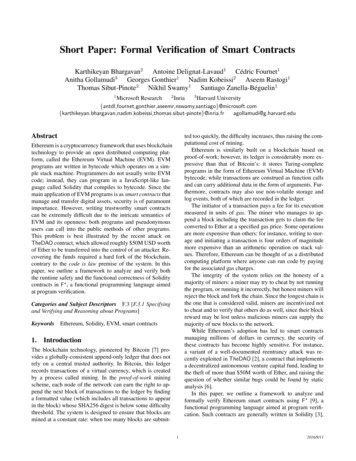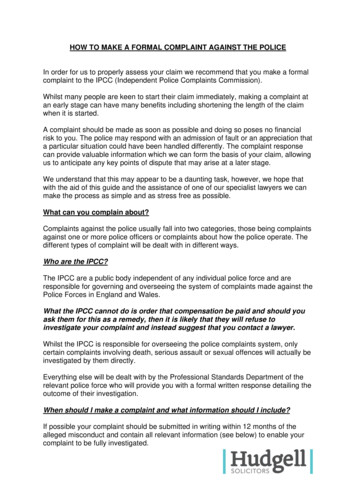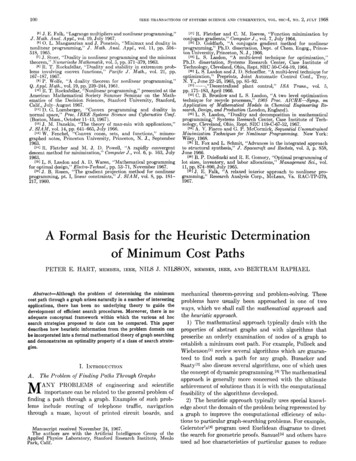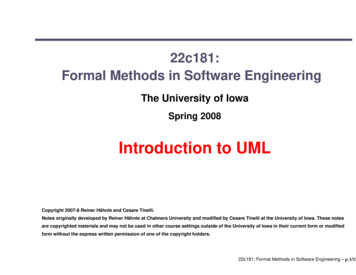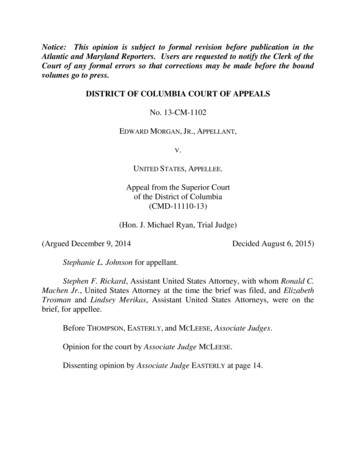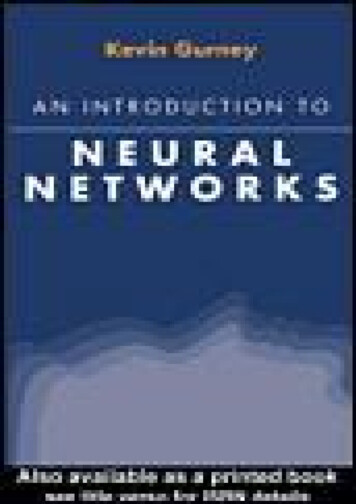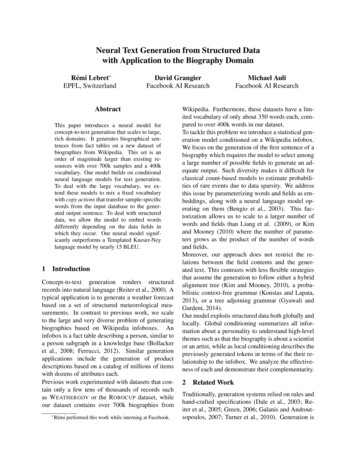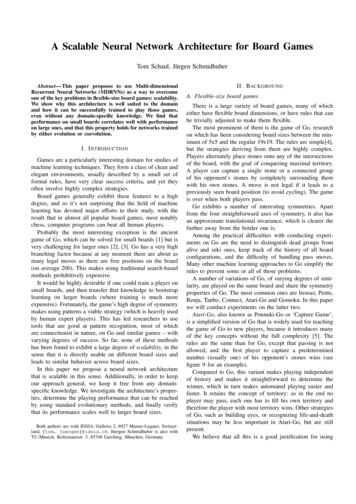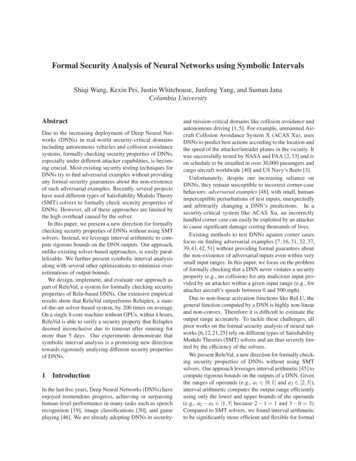
Transcription
Formal Security Analysis of Neural Networks using Symbolic IntervalsShiqi Wang, Kexin Pei, Justin Whitehouse, Junfeng Yang, and Suman JanaColumbia UniversityAbstractDue to the increasing deployment of Deep Neural Networks (DNNs) in real-world security-critical domainsincluding autonomous vehicles and collision avoidancesystems, formally checking security properties of DNNs,especially under different attacker capabilities, is becoming crucial. Most existing security testing techniques forDNNs try to find adversarial examples without providingany formal security guarantees about the non-existenceof such adversarial examples. Recently, several projectshave used different types of Satisfiability Modulo Theory(SMT) solvers to formally check security properties ofDNNs. However, all of these approaches are limited bythe high overhead caused by the solver.In this paper, we present a new direction for formallychecking security properties of DNNs without using SMTsolvers. Instead, we leverage interval arithmetic to compute rigorous bounds on the DNN outputs. Our approach,unlike existing solver-based approaches, is easily parallelizable. We further present symbolic interval analysisalong with several other optimizations to minimize overestimations of output bounds.We design, implement, and evaluate our approach aspart of ReluVal, a system for formally checking securityproperties of Relu-based DNNs. Our extensive empiricalresults show that ReluVal outperforms Reluplex, a stateof-the-art solver-based system, by 200 times on average.On a single 8-core machine without GPUs, within 4 hours,ReluVal is able to verify a security property that Reluplexdeemed inconclusive due to timeout after running formore than 5 days. Our experiments demonstrate thatsymbolic interval analysis is a promising new directiontowards rigorously analyzing different security propertiesof DNNs.1IntroductionIn the last five years, Deep Neural Networks (DNNs) haveenjoyed tremendous progress, achieving or surpassinghuman-level performance in many tasks such as speechrecognition [19], image classifications [30], and gameplaying [46]. We are already adopting DNNs in security-and mission-critical domains like collision avoidance andautonomous driving [1, 5]. For example, unmanned Aircraft Collision Avoidance System X (ACAS Xu), usesDNNs to predict best actions according to the location andthe speed of the attacker/intruder planes in the vicinity. Itwas successfully tested by NASA and FAA [2, 33] and ison schedule to be installed in over 30,000 passengers andcargo aircraft worldwide [40] and US Navy’s fleets [3].Unfortunately, despite our increasing reliance onDNNs, they remain susceptible to incorrect corner-casebehaviors: adversarial examples [48], with small, humanimperceptible perturbations of test inputs, unexpectedlyand arbitrarily changing a DNN’s predictions. In asecurity-critical system like ACAS Xu, an incorrectlyhandled corner case can easily be exploited by an attackerto cause significant damage costing thousands of lives.Existing methods to test DNNs against corner casesfocus on finding adversarial examples [7, 16, 31, 32, 37,39, 41, 42, 51] without providing formal guarantees aboutthe non-existence of adversarial inputs even within verysmall input ranges. In this paper, we focus on the problemof formally checking that a DNN never violates a securityproperty (e.g., no collision) for any malicious input provided by an attacker within a given input range (e.g., forattacker aircraft’s speeds between 0 and 500 mph).Due to non-linear activation functions like ReLU, thegeneral function computed by a DNN is highly non-linearand non-convex. Therefore it is difficult to estimate theoutput range accurately. To tackle these challenges, allprior works on the formal security analysis of neural networks [6,12,21,25] rely on different types of SatisfiabilityModulo Theories (SMT) solvers and are thus severely limited by the efficiency of the solvers.We present ReluVal, a new direction for formally checking security properties of DNNs without using SMTsolvers. Our approach leverages interval arithmetic [45] tocompute rigorous bounds on the outputs of a DNN. Giventhe ranges of operands (e.g., a1 [0, 1] and a2 [2, 3]),interval arithmetic computes the output range efficientlyusing only the lower and upper bounds of the operands(e.g., a2 a1 [1, 3] because 2 1 1 and 3 0 3).Compared to SMT solvers, we found interval arithmeticto be significantly more efficient and flexible for formal
analysis of a DNN’s security properties.Operationally, given an input range X and security property P, ReluVal propagates it layer by layer to calculatethe output range, applying a variety of optimizations toimprove accuracy. ReluVal finishes with two possibleoutcomes: (1) a formal guarantee that no value in X violates P (“secure”); and (2) an adversarial example in Xviolating P (“insecure”). Optionally, ReluVal can alsoguarantee that no value in a set of subintervals of X violates P (“secure subintervals”) and that all remainingsubintervals each contains at least one concrete adversarial example of P (“insecure subintervals”).A key challenge in ReluVal is the inherent overestimation caused by the input dependencies [8, 45] when interval arithmetic is applied to complex functions. Specifically, the operands of each hidden neuron depend onthe same input to the DNN, but interval arithmetic assumes that they are independent and may thus computean output range much larger than the true range. Forexample, consider a simplified neural network in whichinput x is fed to two neurons that compute 2x and xrespectively, and the intermediate outputs are summed togenerate the final output f (x) 2x x. If the input rangeof x is [0, 1], the true output range of f (x) is [0, 1]. However, naive interval arithmetic will compute the range off (x) as [0, 2] [0, 1] [ 1, 2], introducing a huge overestimation error. Much of our research effort focuses onmitigating this challenge; below we describe two effectiveoptimizations to tighten the bounds.First, ReluVal uses symbolic intervals whenever possible to track the symbolic lower and upper bounds of eachneuron. In the preceding example, ReluVal tracks theintermediate outputs symbolically ([2x, 2x] and [ x, x]respectively) to compute the range of the final outputas [x, x]. When propagating symbolic bound constraintsacross a DNN, ReluVal correctly handles non-linear functions such as ReLUs and calculates proper symbolic upperand lower bounds. It concretizes symbolic intervals whenneeded to preserve a sound approximation of the trueranges. Symbolic intervals enable ReluVal to accuratelyhandle input dependencies, reducing output bound estimation errors by 85.67% compared to naive extension basedon our evaluation.Second, when the output range of the DNN is too largeto be conclusive, ReluVal iteratively bisects the inputrange and repeats the range propagation on the smallerinput ranges. We term this optimization iterative intervalrefinement because it is in spirit similar to abstractionrefinement [4, 18]. Interval refinement is also amenableto massive parallelization, an additional advantage of ReluVal over hard-to-parallelize SMT solvers.Mathematically, we prove that interval refinement onDNNs always converges in finite steps as long as the DNNis Lipschitz continuous which is true for any DNN withfinite number of layers. Moreover, lower values of Lipschitz constant result in faster convergence. Stable DNNsare known to have low Lipschitz constants [48] and therefore the interval refinement algorithm can be expectedto converge faster for such DNNs. To make interval refinement even more efficient, ReluVal uses additionaloptimizations that analyze how each input variable influences the output of a DNN by computing each layer’sgradients to input variables. For instance, when bisectingan input range, ReluVal picks the input variable range thatinfluences the output the most. Further, it looks for inputvariable ranges that influence the output monotonically,and uses only the lower and upper bounds of each suchrange for sound analysis of the output range, avoidingsplitting any of these ranges.We implemented ReluVal using around 3,000 line ofC code. We evaluated ReluVal on two different DNNs,ACAS Xu and an MNIST network, using 15 security properties (out of which 10 are the same ones used in [25]).Our results show that ReluVal can provide formal guarantees for all 15 properties, and is on average 200 timesfaster than Reluplex, a state-of-the-art DNN verifier usinga specialized solver [25]. ReluVal is even able to provea security property within 4 hours that Reluplex [25]deemed inconclusive due to timeout after 5 days. ForMNIST, ReluVal verified 39.4% out of 5000 randomlyselected test images to be robust against up to X 5attacks.This paper makes three main contributions. To the best of our knowledge, ReluVal is the firstsystem that leverages interval arithmetic to provideformal guarantees of DNN security. Naive application of interval arithmetic to DNNs isineffective. We present two optimizations – symbolic intervals and iterative refinement – that significantly improve the accuracy of interval arithmeticon DNNs. We designed, implemented, evaluated our techniquesas part of ReluVal and demonstrated that it is onaverage 200 faster than Reluplex, a state-of-the-artDNN verifier using a specialized solver [25].22.1BackgroundPreliminary of Deep LearningA typical feedforward DNN can be thought of as afunction f : X Y mapping inputs x X (e.g., images, texts) to outputs y Y (e.g., labels for imageclassification, texts for machine translation). Specifically, f is composed of a sequence of parametric functions f (x; w) fl ( fl 1 (· · · f2 ( f1 (x; w1 ); w2 ) · · · wl 1 ), wl ),
where l denotes the number of layers in a DNN, fk denotes the corresponding transformation performed by kth layer, and wk denotes the weight parameters of k-thlayer. Each fk 1,.l performs two operations: (1) a linear transformation of its input (i.e., either x or the outputfrom fk 1 ) denoted by wk · fk 1 (x), where f0 (x) x andfk 0 (x) is the output of fk denoting intermediate outputof layer k while processing x, and (2) a nonlinear transformation σ (wk · fk 1 (x)) where σ is the nonlinear activation function. Common activation functions includesigmoid, hyperbolic tangent, or ReLU (Rectified LinearUnit) [38]. In this paper, we focus on DNNs using ReLU(Relu(x) max(0, x)) as the activation function as it isone of the most popular ones used in the modern state-ofthe-art DNN architectures [17, 20, 47].2.2Threat ModelTarget system. In this paper, we consider all types ofsecurity-critical systems, e.g., airborne collision avoidance system for unmanned aircraft like ACAS Xu [33],which use DNNs for decision making in the presenceof an adversary/intruder. DNNs are becoming increasingly popular in such systems due to better accuracy andless performance overhead than traditional rule-based systems [24]. For example, an aircraft collision avoidancesystem’s decision-making process can use DNNs to predict the best action based on sensor data of the currentspeed and course of the aircraft, those of the adversary,and distances between the aircraft and nearby intruders.Figure 1: The DNN in the victim aircraft (ownship)should predict a left turn (upper figure) but unexpectedly advises to turn right and collides with the intruder(lower figure) due to the presence of adversarial inputs(e.g., if the attacker approaches at certain angles).Security properties. In this paper, we focus on input-output-based security properties of DNN-based systemsthat ensure the correct actions in the presence of adversarial inputs within a given range. Input-output properties arewell suited for the DNN-based systems as their decisionlogic is often opaque even to their designers. Therefore,unlike traditional programs, writing complete specifications involving internal states is often hard.For example, consider a security property that triesto ensure that a DNN-based car crash avoidance systempredicts the correct steering angle in the presence of anapproaching attacker vehicle: it should steer left if theattacker approaches it from right. In this setting, eventhough the final decision is easy to predict for humans,the correct outputs for the internal neurons are hard topredict even for the designer of the DNN.Attacker model. We assume that the inputs an adversary can provide are bounded within an interval specifiedby a security property. For example, an attacker aircrafthas a maximum speed (e.g., it can only move between 0and 500 mph). Therefore, the attacker is free to chooseany value within that range. This attacker model is, inessence, similar to the ones used for adversarial attackson vision-based DNNs where the attacker aims to searchfor visually imperceptible perturbations (within certainbound) that, when applied on the original image, makesthe DNN predict incorrectly. Note that, in this setting, theimperceptibility is measured using a L p norm. Formally,given a computer vision DNN f , the attacker solves following optimization problem: min(L p (x x)) such thatf (x) f (x ), where L p (·) denotes the p-norm and x xis the perturbation applied to original input x. In otherwords, the security property of a vision DNN being robustagainst adversarial perturbations can be defined as: forany x within a L-distance ball of x in the input space,f (x) f (x ).Unlike the adversarial images, we extend the attackermodel to allow different amounts of perturbations to different features. Specifically, instead of requiring overallperturbations on input features to be bounded by L-norm,our security properties allow different input features tobe transformed within different intervals. Moreover, forDNNs where the outputs are not explicit labels, unlikeadversarial images, we do not require the predicted labelto remain the same. We support properties specifyingarbitrary output intervals.An example. As shown in Figure 1, normally, when thedistance (one feature of the DNN) between the victimship (ownship) and the intruder is large, the victim shipadvisory system will advise left to avoid the collisionand then advise right to get back to the original track.However, if the DNN is not verified, there may exist onespecific situation where the advisory system, for certainapproaching angles of the attacker ship, advises the shipincorrectly to take a right turn instead of left, leading to a
fatal collision. If an attacker knows about the presence ofsuch an adversarial case, he can specifically approach theship at the adversarial angle to cause a collision.2.3IntruderapproachingangleInterval AnalysisInterval arithmetic studies the arithmetic operations onintervals rather than concrete values. As discussed above,since (1) the DNN safety property checking requires setting input features within certain ranges and checking theoutput ranges for violations, and (2) the DNN computations only include additions and multiplications (lineartransformations) and simple nonlinear operations (e.g.,ReLUs), interval analysis is a natural fit to our problem.We provide some formal definitions of interval extensionsof functions and their properties below. We use thesedefinitions in Section 4 for demonstrating the correctnessof our algorithm.Formally, let x denote a concrete real value and X : [X, X] denote an interval, where X is the lower bound,and X is the upper bound. An interval extension of afunction f (x) is a function of intervals F such that, forany x X, F([x, x]) f (x). The ideal interval extensionF(X) approaches the image of f , f (X) : { f (x) : x X}.Let f (X1 , X2 , ., Xd ) : { f (x1 , x2 , ., xd ) : x1 X1 , x2 X2 , ., xd Xd } where d is the number of input dimensions. An interval valued function F(X1 , X2 , ., Xd ) isinclusion isotonic if, when Yi Xi for i 1, ., d, we haveF(Y1 ,Y2 , .,Yd ) F(X1 , X2 , ., Xd )An interval extension function F(X) that is defined onan interval X0 is said to be Lipschitz continuous if there issome number L such that: X X0 , w(F(X)) L · w(X)where w(X) is the width of interval X, and X here denotesX (X1 , X2 , ., Xd ), a vector of intervals [45].3Distance fromintruderOverviewInterval analysis is a natural fit to the goal of verifyingsafety properties in neural networks as we have discussedin Section 2.3. Naively, by setting input features as intervals, we could follow the same arithmetic performed inthe DNN to compute the output intervals. Based on theoutput intervals, we can verify if the input perturbationswill finally lead to violations or not (e.g., output intervalsgo beyond a certain bound). Note that, lack of violationsindicates the safety property is verified to be safe due toover-approximations.However, naively computing output intervals in thisway suffers from high errors as it computes extremely21131-1Steering angleFigure 2: Running example to demonstrate our techniques.loose bounds due to the dependency problem. In particular, it can only get a highly conservative estimation of theoutput range, which is too wide to be useful for checkingany safety property. In this section, we first demonstratethe dependency problem with a motivating example usingnaive interval analysis. Next, based on the same example,we describe how the techniques described in this papercan mitigate this problem.A working example. We use a small motivating example shown in Figure 2 to illustrate the inter-dependencyproblem and our techniques in dealing with this problemin Figure 3.Let us assume that the sample NN is deployed in an unmanned aerial vehicle taking two inputs (1) distance fromthe intruder and (2) intruder approaching angle, whileproducing the steering angle as output. The NN has fiveneurons arranged in three layers. The weights attached toeach edge is also shown in Figure 3 .Assume that we aim to verify if the predicted steeringangle is safe by checking a property that the steering angleshould be less than 20 if the distance from the intruder isin [4, 6] and the possible angle of approaching intruder isin [1, 5].Let x denote the distance from an intruder and y denote the approaching angle of the intruder. Essentially,given x [4, 6] and y [1, 5], we aim to assert thatf (x, y) [ , 20]. Figure 3a illustrates the naive interval propagation in this NN. By performing the intervalmultiplications and additions, along with applying theReLU activation functions, we get the output interval tobe [0, 22]. Note that this is an overestimation because theupper bound 22 cannot be achieved: it can only appearwhen the left hidden neuron outputs 27 and the right oneoutputs 5. However, for the left hidden neuron to output27, the conditions x 6 and y 5 have to be satisfied.Similarly, for the right hidden neuron to output 5, theconditions x 4 and y 1 have to be satisfied. Thesetwo conditions are contradictory and therefore cannot be
3][3,5]y2[5,11][11,27][5,11][2x 3y, 2x 3y][11,27]132113[5,11]1-1[x y,x y][5,11][11,21][17,27]1-11[5,9][7,11][x 2y,x 2y][0,22](a) Naive interval propagation[6,16](b) Symbolic interval propagation[2,16]U[6,20] [2,20](c) Iterative bisection and refinementFigure 3: Examples showing (a) naive interval extension where the output interval is very loose as it ignores theinter-dependency of the input variables, (b) using symbolic interval analysis to keep track of some of the dependencies,and (c) using bisection to reduce the over-approximation error.satisfied simultaneously and therefore the final output 22can never appear. This effect is known as the dependencyproblem [45].As we have defined that a safe steering angle mustbe less than or equal to 20, we cannot guarantee nonexistence of violations, as the steering angle can have avalue as high as 22 according to the naive interval propagation described above.Symbolic interval propagation. Figure 3b demons
analysis of a DNN’s security properties. Operationally, given an input range X and security prop- erty P, ReluVal propagates it layer by layer to calculate the output range,

